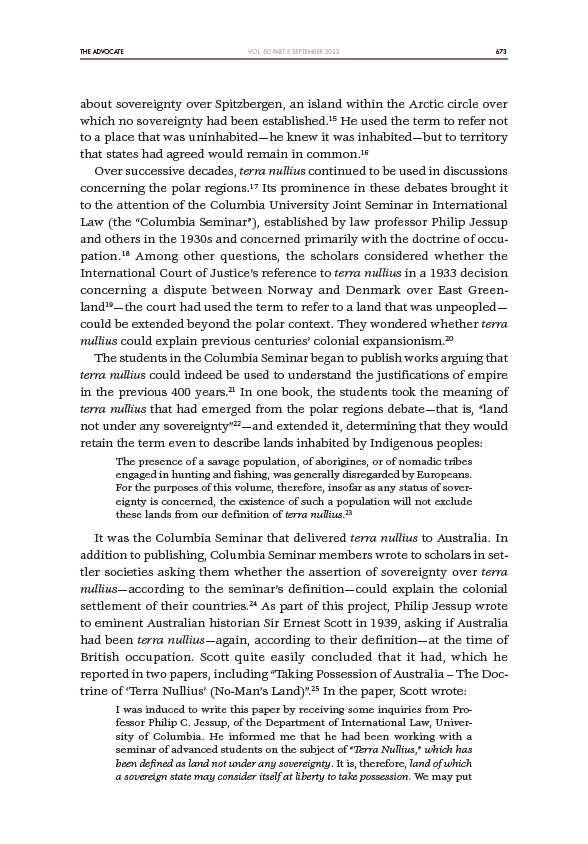
THE ADVOCATE 673
VOL. 80 PART 5 SEPTEMBER 2022
about sovereignty over Spitzbergen, an island within the Arctic circle over
which no sovereignty had been established.15 He used the term to refer not
to a place that was uninhabited—he knew it was inhabited—but to territory
that states had agreed would remain in common.16
Over successive decades, terra nullius continued to be used in discussions
concerning the polar regions.17 Its prominence in these debates brought it
to the attention of the Columbia University Joint Seminar in International
Law (the “Columbia Seminar”), established by law professor Philip Jessup
and others in the 1930s and concerned primarily with the doctrine of occupation.
18 Among other questions, the scholars considered whether the
International Court of Justice’s reference to terra nullius in a 1933 decision
concerning a dispute between Norway and Denmark over East Greenland19—
the court had used the term to refer to a land that was unpeopled—
could be extended beyond the polar context. They wondered whether terra
nullius could explain previous centuries’ colonial expansionism.20
The students in the Columbia Seminar began to publish works arguing that
terra nullius could indeed be used to understand the justifications of empire
in the previous 400 years.21 In one book, the students took the meaning of
terra nullius that had emerged from the polar regions debate—that is, “land
not under any sovereignty”22—and extended it, determining that they would
retain the term even to describe lands inhabited by Indigenous peoples:
The presence of a savage population, of aborigines, or of nomadic tribes
engaged in hunting and fishing, was generally disregarded by Europeans.
For the purposes of this volume, therefore, insofar as any status of sovereignty
is concerned, the existence of such a population will not exclude
these lands from our definition of terra nullius.23
It was the Columbia Seminar that delivered terra nullius to Australia. In
addition to publishing, Columbia Seminar members wrote to scholars in settler
societies asking them whether the assertion of sovereignty over terra
nullius—according to the seminar’s definition—could explain the colonial
settlement of their countries.24 As part of this project, Philip Jessup wrote
to eminent Australian historian Sir Ernest Scott in 1939, asking if Australia
had been terra nullius—again, according to their definition—at the time of
British occupation. Scott quite easily concluded that it had, which he
reported in two papers, including “Taking Possession of Australia – The Doctrine
of ‘Terra Nullius’ (No-Man’s Land)”.25 In the paper, Scott wrote:
I was induced to write this paper by receiving some inquiries from Professor
Philip C. Jessup, of the Department of International Law, University
of Columbia. He informed me that he had been working with a
seminar of advanced students on the subject of “Terra Nullius,” which has
been defined as land not under any sovereignty. It is, therefore, land of which
a sovereign state may consider itself at liberty to take possession. We may put